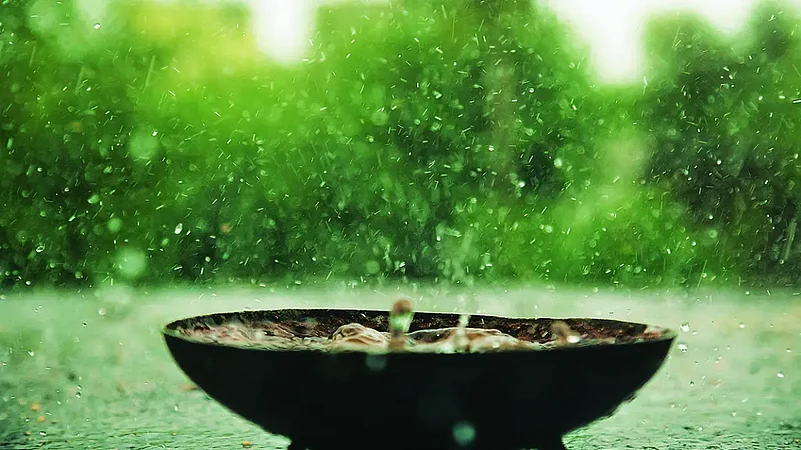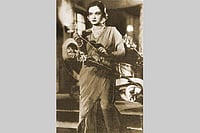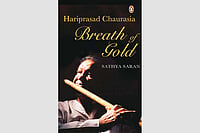Very close to the city famous for its bird sanctuary lies the stunning Deeg Palace built by the Jat rulers of Bharatpur in the mid-eighteenth century. These rulers had gained independence from the Mughals and were setting themselves up as an important political force. Bharatpur is in the Braj region, and the rulers were devotees of Lord Krishna. The palace garden, which has large water tanks and fountains (defunct now) was designed to replicate the monsoon all year round. And amidst it lies a large stone arch taken from Shah Jahan’s palace in Agra, and installed by the Bharatpur rulers for use as a monsoon swing or jhoola. The Jhoola genre has a special place in the terrain of semi-classical Indian music, and brings with it a musical lilt, a sway. This form borrows from folk music and is typically sung during the monsoon.
There was a time when young girls and women indulged themselves on the jhoola, tied to branches of trees, setting aside their daily chores, in a feeling of abandon, peace and joy with the cool breeze kissing their faces, as it traced its arc through the air. It gave them a sense of reaching the skies, like a gentle adventure sport. If one were to compare it with a more popular activity in the present, it would perhaps be what tourists feel while paragliding in Bir Billing. A lot of the Jhoola repertoire also brought with it a camaraderie between the women, a space for the sakhis (friends), for musical banter with pleasing themes where the missing lover is remembered with affection. Or the beautiful ambua (mango) tree from where it hangs, or the onset of the monsoon with the kaare badra (black clouds) or even invoking an auspicious aura that would become the song.
In the North Indian semi-classical repertoire, sub-genres like the Kajri and Chaiti, largely from the Awadh and Banaras-Mirzapur regions, are sung according to the season—Kajris during the monsoon and Chaiti during the month of chait, around March-April. While the origin of several of these forms lie in the desi (or folk) music of the region known as purab (eastern UP and Bihar)—the singers at Wajid Ali Shah’s court sang their desi kajris, horis and dadras—but they entered the realm of the margi by bringing in Raagdari into it around the mid-eighteenth century. However, it would be alright to say that they haven’t quite lost their desi flavour.

In India, the monsoon is not merely yet another season, it’s a cultural phenomenon. It is of matchless historical importance in the world of Indian music. Music scholar Katherine Butler Schofield suggests the word “monsoon” itself comes from a Portuguese corruption of the Arabic word mausam or season. It is of vital significance as the monsoon rains—intense, heavy, warm downpours—cool and replenish the overheated earth and make it fertile. Indian agriculture and fresh water supplies are largely dependent upon the rainy season, and the monsoon itself has determined over centuries what kinds of crops are cultivated and where, what kind of food eaten and how. If the monsoon arrives as anticipated there will be a bountiful harvest and money in people’s pockets; if it is strong there will be flooding, damage and loss of life; but if it is weak and scanty, there will be famine, rioting, and death. And so it is inextricably intertwined with life and society.
In the agricultural cycle, the rainy season is when agricultural activity is at its slowest, making it the ideal time for wives to spend a couple of months with their natal families. In her book Unearthing Gender, Smita Jassal suggests that women’s lack of autonomy emerges as the key since this leave, more likely to be understood as “time for play”, must be effectively and strategically negotiated, as is demonstrated by the mood of coaxing and cajoling in the Kajri the women sing. The songs are light-hearted and deceptively simple but provide an unexpected window to the contexts within which women must negotiate their time away from work. A Kajri sourced from the agricultural fields in UP, goes like this:
Ayi re jijiya kajariya more sam, kajariya more sam
Kajariya khelei ja vai re naiharava , kajariya khelei ja vai re
Jab tum raniya kajariya khelei ja¯yau, tikuliya¯dhare jaye re sejariya¯Nathuniya¯dhare jaye re
(It’s the rainy season, love, the season of kajri
To frolic in the rains I go to my natal home, to play kajri I go.
When you go, my queen, to play kajri, be sure to leave your forehead ornament on the bed…). The song lists various kinds of jewellery, a significant marker of matrimony, and this casting off of women’s jewellery, perhaps, metaphorically suggests a brief liberation from women’s primary roles, which are characterised by subservience and duty.
Even in the classical realm there is a subversive, witty, satirical and sometimes even a spiritual sub-text. Like the thumri, the Kajri and the Jhoola are also characterised by an emphasis on emotional expression that is usually absent from the other main genres. There are deep, instinctive links between the anticipation of the rains and their arrival, and their emotional resonances of longing for love and fulfilment. Schofield makes the connection historically between monsoon and music. Certain natural signs of the rainy season, particularly migrating and breeding birds, have become particularly intense signifiers in poetry, art and music of these cyclical emotions of longing, fulfilment and romance—viraha and sringara.
Hundreds of songs have been written about the onset of the monsoon, with its dark clouds, rolling thunder, flash of lightning, pitter-patter of raindrops and the fresh smell of the damp earth—replete with the imagery of the daadur, mor and the papiha singing its love songs, and young woman sending messages to her husband via the dark clouds to return home; the whole atmosphere is robust with emotions of love and longing. Siddheshwari Devi’s rendition of Suhagan barasat kaahe nahi re or the Barsan laagi saawan bundiya, sung by the legend Vidushi Girija Devi. Or who can forget Begum Akhtar’s Chha rahi kaali ghata; all of these evoke layers of feelings all at once.
Then again, the world of Malhars in the domain of khayal is enormous. The Malhar group of raag constitutes a major branch of the Hindustani stream. These melodies too have an intimate association with the seasonal and rustic elements of the land and have come to be firmly ensconced in the musical palate of nouveau and the connoisseurs alike. One could feel totally drenched in the variety of the Malhars—Sur, Nat, Ramdasi, Gaud, Chhaya and Megh, to name less than a handful. The notes and glides in the raag almost seem to coalesce with the looming clouds and the tempestuous thunder, creating the idea of a vast expanse, a cradle of intensity and sensuousness all at once. The book Raga Malhar Darshan by Dr Geeta Banerjee is a detailed and highly enjoyable account of the varieties of Malhars and bandishes.
Undoubtedly, one of the more delightful aspects of North Indian music is how it provides for different occasions—seasons, festivals, rituals, celebrations. For a lot of us “boomers”, or Generation X, unlike the millennials or Gen Z, there’s a lot about feeling this music, embodied memories that exist in these affective microcosms. A more sophisticated, emotional and richer experience than perhaps in a runaway hit like Sawan me lag gayi aag!
(Views expressed are personal. )
(This appeared in the print edition as "Drenched in Music")

























